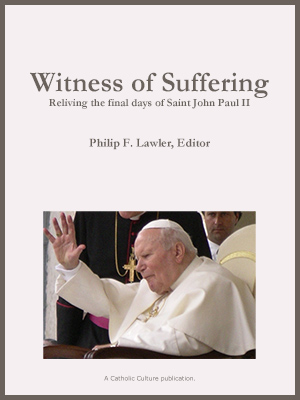The MOST Theological Collection: Outline of Christology
"XIII. Cana"
Jesus and His disciples attend the wedding. During it His Mother gives a hint: "They have no wine."
Three things need explanation. First, He uses the word "woman" instead of Mother. That term would be respectful in the language of the time. But we still wonder why He used it. He did the same at the Cross. After saying "Son behold your Mother", the normal complement would be:"Mother behold your son." But instead the Gospel reports: "Woman behold your son." Pope John Paul II in Redemptoris Mater §24 [italics in original] gives a solution favored by many exegetes: "It is significant that, as he speaks to his mother from the Cross, he calls her 'woman' and says to her. 'Woman, behold your son!' Moreover, he had addressed her by the same term at Cana too (cf. Jn 2:4). How can one doubt that especially now, on Golgotha, this expression goes to the very heart of the mystery of Mary, and indicates the unique place which she occupies in the whole economy of salvation?... . The words uttered by Jesus from the Cross signify that the motherhood of her who bore Christ finds a 'new' continuation in the Church and through the Church symbolized and represented by John... . through the Church [she] remains in that mystery as 'the woman' spoken of by the Book of Genesis (3:15) at the beginning and by the Apocalypse (12:1) at the end of the history of salvation... . Mary's 'motherhood' of the Church is the reflection and extension of her motherhood of the Son of God."
We know that the Evangelists might change the wording, while keeping the sense (cf. Biblical Commission Instruction of 1964). Hence the sacred authors may have used that word woman precisely to indicate the connection of which the Pope spoke.
We notice too the problem raised by His words: 'What is it to you and to me?" (We have given a literal translation; published translations often try to soften the words). There are two types of use of this expression in the Old Testament. First, if one is bothering another, the latter may say this, in the sense of: "What did I do to bring this on?" Examples of this are found in Judges 11. 12; 2 Chron. 35. 21; 1 Kings 17. 18. The expression is also used when someone is asked to get into something he feels is not his affair. It then means: "That is your affair, not mine". Examples are: 1 Kings 3. 13; Hosea 14. 8. Here it seems best to treat it as a seeming rejection, in line with the OT examples, but one intended to call on her to work, to hold on in the dark - we explained this above. She did hold on, she held onto confidence and hence told the waiters to do whatever He would say.
A question is also raised about the fact that He said His hour had not yet come. Some take this to mean the time of His death, and then are apt to add that then her association with Him, her hour and His, will really begin. Then they would say that at Cana He was still in the hour of His Father, the hour of doing what the Father willed. But it seems more natural to say that the words "my hour" need not have the same sense everywhere in John's Gospel - so many words and expressions do shifting sense. So the hour would be the time He had fixed for His first miracle.
In either case, her power of intercession shows for the first time.
Just incidentally it was quite a quantity of wine He made. It would be 15 to 25 gallons ( that is, two or three measures each). The jars were made of stone for reasons of levitical purity, If an earthenware jar became ritually unclean it would have to be broken, but a stone jar would not be broken. (Cf. Lev 11. 29-38 ).
The Council of Trent defined that Jesus instituted marriage as a sacrament (DS 1801), but did not say on what occasion He did that. Some think it was done at Cana. Others think it was when He in Mt 19. 3-10 restored the unity and indissolubility of marriage. The answer is unclear.






